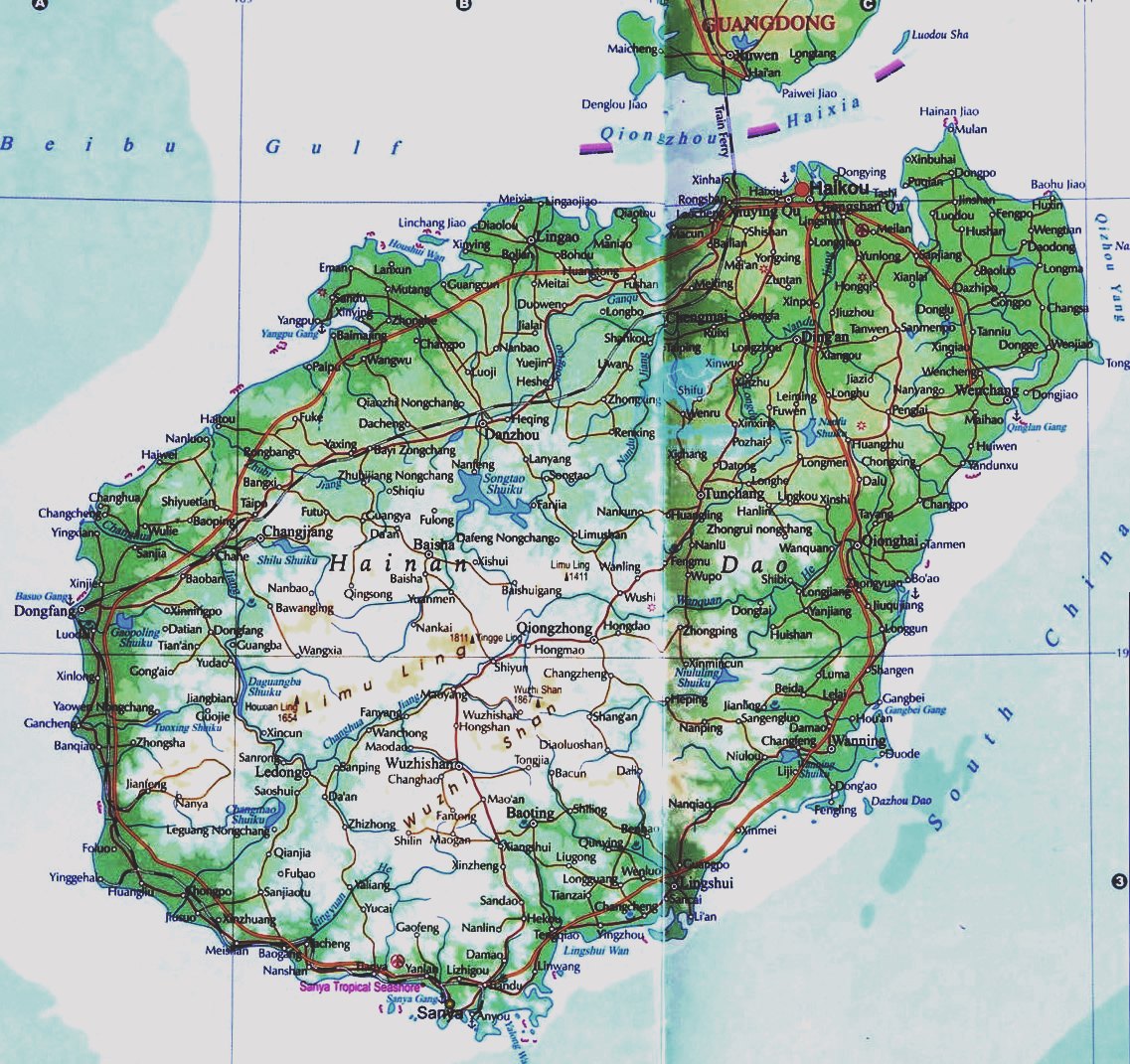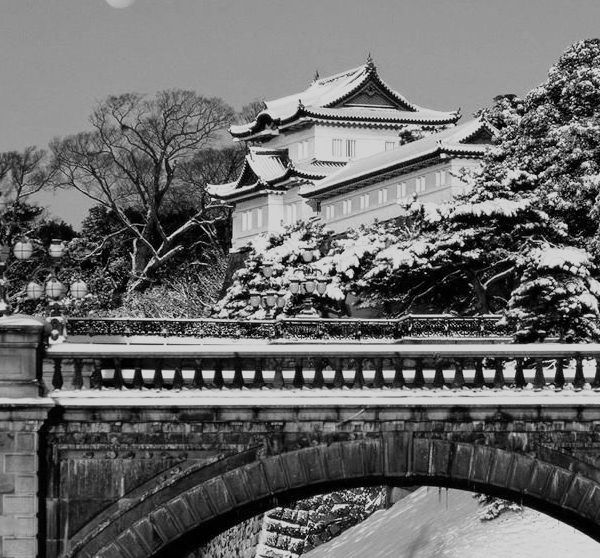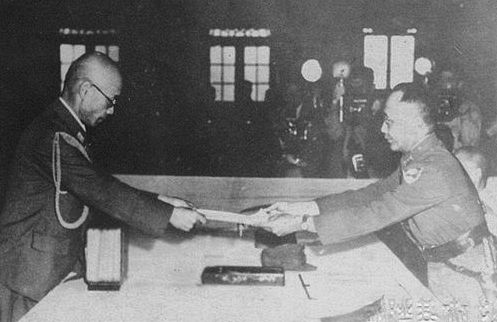SHINYO!
 (Captured EMB under test by an American
soldier)
(Captured EMB under test by an American
soldier)
Explosive Motorboats based
at Hainan Island, China, 1944-1945
© 2011 Bob Hackett and Sander Kingsepp
 Hainan Island showing Haikou (Haikow) and Sanya (Samah)
9 February 1939:
Hainan Island showing Haikou (Haikow) and Sanya (Samah)
9 February 1939:
At midnight, after escorting a convoy, Vice Admiral (later Admiral) Kondo Nobutake’s (former CO of KONGO) 5th Fleet (South China Naval Force) consisting of CruDiv 9's MYOKO (F) and NACHI, light cruisers NATORI and NAGARA, DesDiv 23’s MOCHIZUKI, MUTSUKI, MIKAZUKI and KIKUZUKI, DesDiv 45’s MATSUKAZE and ASAKAZE and DesDiv 28’s YUNAGI and ASANAGI and MinesweepDiv 12 enter and anchor in Tsinghai Bay on the northern shore of Hainan Island. Kondo’s forces then carry out a amphibious assault landing. Air cover is provided by CarDiv 1's AKAGI and seaplane carrier CHIYODA.
10 February 1939:
At 1200, the 4th Base Force’s 4th Yokosuka, 6th Kure and 8th Sasebo Special Naval Landing Forces (SNLF) effect a landing at Haikow. Thereafter, IJA MajGen Iida Shojiro’s Taiwan Mixed Brigade consisting of the 1st and 2nd Infantry and Mountain Gun Regiments and Navy SNLF forces mop up the northern part of the island.
11 February 1939:
Combat units land at Samah at the southern Hainan Island and occupy Yulin (Samah) and Yai-Hsien. Thereafter, these units and the 5th Garrison Unit occupy and subjugate the entire island. Later, Hainan Guard District Headquarters is established at Samah.
1941:
Samah becomes home port for the IJNs Second Fleet and is the main embarkation point for Operation “E” - the Invasions of Malaya and Thailand.
15 November 1944:
The 28th Shinyo Squadron is organized under Lt (j.g.) Uramoto with an authorized strength of 53 Type 1 Shinyo Explosive Motorboats (EMB) and 191 men. That same day, the 30th Shinyo Squadon is formed under Lt (j.g.) Yamamoto Masamoto with 54 authorized Type 1 EMBs and 191 men. Later, Lt (j.g.) Uraki Sei is the CO. The IJN bases both of these units near the large northern Hainan port of Haikou.
18 January 1945:
The IJN organizes the 32nd Shinyo Squadon under Lt (j.g.) Tsujita with an authorized strength of 50 Type 1 EMB and 185 men. The IJN plans to base the 32nd Shinyo Squadon off Shinchiku Bay (now Xincun Bay).
That same day, the 33rd Shinyo Squadon is organized under Lt Fukuda with 49 authorized Type 1 EMBs and and 187 men. That same day, the 103rd Shinyo Squadon is formed under Ensign Masuda with an authorized strength of 25 Type 5 EMBs and 186 men.
 A two-man Type 5 EMB at speed
The IJN bases the 33rd and 103rd Shinyo Squadons in southern Hainan Island near the large port of Yulin at Samah (Sanya).
15 August 1945: Cessation of Hostilities:
A two-man Type 5 EMB at speed
The IJN bases the 33rd and 103rd Shinyo Squadons in southern Hainan Island near the large port of Yulin at Samah (Sanya).
15 August 1945: Cessation of Hostilities:
Imperial Palace, Tokyo. At noon, the Emperor announces Japan's surrender that is broadcast by radio all over the Japanese Empire.
 Imperial Palace, Tokyo
During the course of the war, 28th Shinyo Squadon looses three men, the 32nd and 33rd Shinyo Squadon each lose one man and the 103th Shinyo Squadon looses two men, all to unknown causes.
2 September 1945: Japan Surrenders:
Imperial Palace, Tokyo
During the course of the war, 28th Shinyo Squadon looses three men, the 32nd and 33rd Shinyo Squadon each lose one man and the 103th Shinyo Squadon looses two men, all to unknown causes.
2 September 1945: Japan Surrenders:
Tokyo Bay. The Japanese formally surrender to the Allies by signing the Instrument of Surrender aboard the USS MISSOURI (BB-63). Immediately following the signing ceremony, General of the Army Douglas MacArthur, Supreme Commander for the Allied Powers (SCAP), issues General Order No. 1 for the surrender of Japanese forces. It assigns responsibility for demobilizing Japanese forces in China, Indochina and Formosa to Generalissimo Chiang Kai-shek.
 USS MISSOURI (BB-63)(left) transferring personnel to USS IOWA (BB-61) off Japan on 20 Aug 45.
USS MISSOURI (BB-63)(left) transferring personnel to USS IOWA (BB-61) off Japan on 20 Aug 45.
9 September 1945: Japan Surrenders China
Nanjing (Nanking). The C-in-C of the IJA's China Expeditionary Army, LtGen Okamura Yasuji surrenders China to General He (Ho) Yingqin in accordance with General MacArthur's General Order No. 1.
 Okamura presents the Instrument of Surrender of China to General He.
Okamura presents the Instrument of Surrender of China to General He.
-Bob Hackett and Sander Kingsepp
Back to Explosive
Motorboats Page










